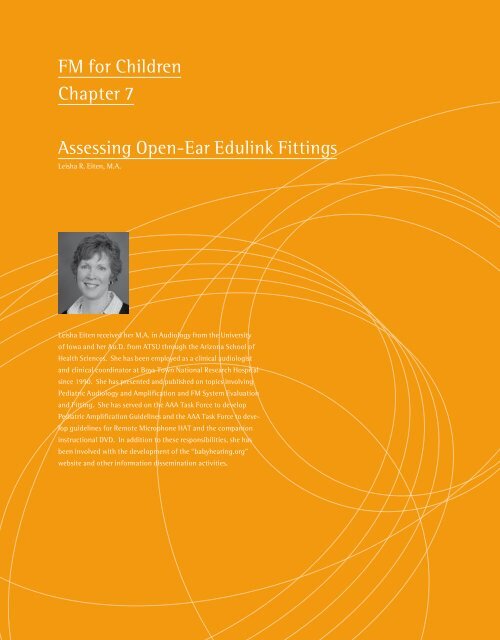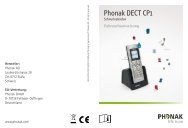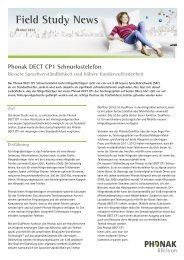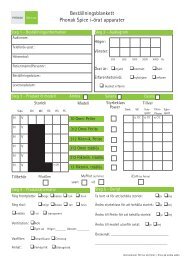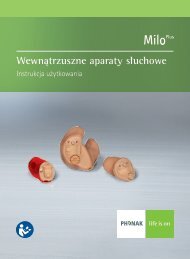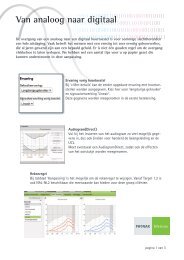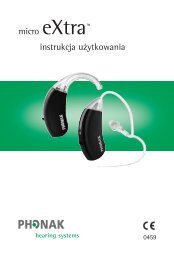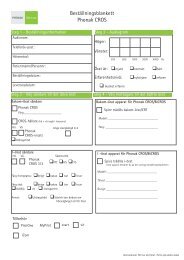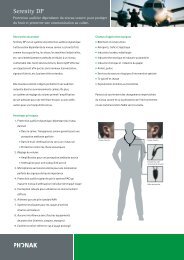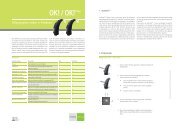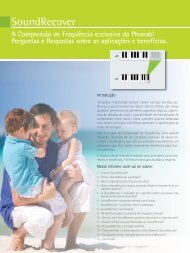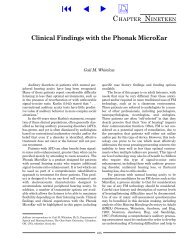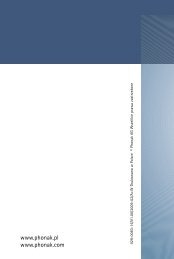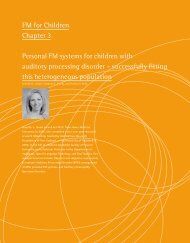Assessing Open-Ear Edulink Fittings - Access 2 Conference - Phonak
Assessing Open-Ear Edulink Fittings - Access 2 Conference - Phonak
Assessing Open-Ear Edulink Fittings - Access 2 Conference - Phonak
You also want an ePaper? Increase the reach of your titles
YUMPU automatically turns print PDFs into web optimized ePapers that Google loves.
FM for Children<br />
Chapter 7<br />
<strong>Assessing</strong> <strong>Open</strong>-<strong>Ear</strong> <strong>Edulink</strong> <strong>Fittings</strong><br />
Leisha R. Eiten, M.A.<br />
Leisha Eiten received her M.A. in Audiology from the University<br />
of Iowa and her Au.D. from ATSU through the Arizona School of<br />
Health Sciences. She has been employed as a clinical audiologist<br />
and clinical coordinator at Boys Town National Research Hospital<br />
since 1990. She has presented and published on topics involving<br />
Pediatric Audiology and Amplification and FM System Evaluation<br />
and Fitting. She has served on the AAA Task Force to develop<br />
Pediatric Amplification Guidelines and the AAA Task Force to develop<br />
guidelines for Remote Microphone HAT and the companion<br />
instructional DVD. In addition to these responsibilities, she has<br />
been involved with the development of the “babyhearing.org”<br />
website and other information dissemination activities.
78 <strong>Assessing</strong> <strong>Open</strong>-<strong>Ear</strong> <strong>Edulink</strong> <strong>Fittings</strong><br />
<strong>Assessing</strong> <strong>Open</strong>-<strong>Ear</strong> <strong>Edulink</strong> <strong>Fittings</strong><br />
Leisha R. Eiten, M.A.<br />
The children that we serve today are using<br />
a wide variety of hearing aid and assistive<br />
technologies. Our priority as audiologists<br />
is to provide the best possible intervention<br />
for a child and to make sure the technology<br />
being used is set appropriately for him or<br />
her. A standardized process is needed for<br />
determining device candidacy and verifying<br />
the function of the many types of technologies<br />
available. Remote-microphone<br />
Hearing Assistance Technology (HAT)<br />
guidelines have recently been published<br />
by the American Academy of Audiology<br />
(American Academy of Audiology [AAA],<br />
2008). The purpose of the guidelines is<br />
to standardize the process of candidacy<br />
determination, selection and implementation<br />
of remote microphone devices. Supplements<br />
on verification procedures for the<br />
different types of HAT devices are being<br />
published in addition to the main guidelines.<br />
The first supplement (Supplement A.<br />
“Fitting and Verification Procedures for<br />
<strong>Ear</strong>-level FM”) has been published with<br />
step-by-step verification procedures specific<br />
to ear-level devices (AAA, 2008).<br />
The guidelines define three main listening<br />
groups as being potential remote-microphone<br />
HAT candidates. They are:<br />
Group 1: Children/Youth with hearing<br />
loss who are current or potential hearing<br />
aid users<br />
Group 2: Children/Youth with Cochlear<br />
Implants<br />
Group 3: Children/Youth with normal<br />
hearing sensitivity who have special<br />
listening needs<br />
Recommended HAT fitting configurations<br />
and additional fitting options are outlined<br />
in the guidelines based on the listener<br />
group. A population that is specifically<br />
addressed in the new guidelines is Group 3:<br />
Children and Youth who have normal<br />
hearing and special listening needs. There<br />
are a wide variety of listening and learning<br />
disorders in this category, including unilateral<br />
or minimal hearing loss, auditory processing<br />
disorders, language-learning delay<br />
or disorders, auditory neuropathy/dyssynchrony<br />
and attention deficit disorders.<br />
Second-language learners may also have<br />
special listening needs and are included in<br />
this listener group.<br />
A common characteristic of this disparate<br />
group is documented evidence of listening<br />
difficulties in adverse acoustic environments.<br />
Listening difficulties for this population<br />
most often occur in high background<br />
noise levels, highly reverberant environments<br />
and when listening from a distance.<br />
These children may also have documented<br />
problems attending in an educational<br />
setting when competing sounds or activities<br />
are present. The remote-microphone<br />
HAT guidelines include instructions for<br />
documentation of listening difficulties and<br />
determining which children would benefit<br />
from a HAT device. Evaluation of word<br />
recognition performance in noise, documentation<br />
of the child’s classroom listening<br />
environment as well as observation and/or<br />
review of the child’s listening performance<br />
in their classroom environment, are all im -<br />
portant for determining if a child would<br />
benefit from remote-microphone assistance.<br />
The remote-microphone HAT<br />
guidelines recommend that audiologists<br />
use tools that provide quantifiable data<br />
and supply information regarding the<br />
child’s performance without the use of the<br />
HAT. In addition, student self-assessment<br />
measures may be used, as well as teacher<br />
and/or parent questionnaires to determine<br />
the child’s emotional status and potential<br />
acceptance of a HAT device in the classroom.<br />
A comprehensive evaluation incorporating<br />
multiple assessments provides a<br />
variety of perspectives of the child’s hearing<br />
and listening performance to assist in<br />
candidacy determination.<br />
A number of other chapters in these<br />
proceedings deal with FM use for children<br />
and adults with auditory neuropathy/dyssynchrony<br />
and auditory processing deficits.<br />
Although unilateral (UHL) and minimal<br />
hearing losses are not discussed in detail<br />
elsewhere in these proceedings, a growing<br />
body of evidence is available about the<br />
listening and learning effects of unilateral<br />
and mild hearing loss (Eichwald & Gabbard,<br />
2008). Children with UHL or minimal loss<br />
are considered candidates for remote-microphone<br />
HAT devices. Particularly when<br />
traditional hearing aid amplification is not<br />
beneficial or acceptable, an HAT option<br />
should be considered.<br />
No specific default arrangement for<br />
remote-microphone HAT is recommended<br />
by the AAA Guidelines for children in<br />
Listener Group 3. FM-only HAT device<br />
options for children with normal hearing<br />
include non-occluding body-worn FM
Leisha R. Eiten<br />
79<br />
systems with headphones or earbuds, personal desk-top and<br />
classroom sound-field devices using infra-red or FM transmission,<br />
and ear-level FM-only devices. The remainder of this chapter will<br />
focus on recommended verification procedures for ear-level FMonly<br />
devices such as the <strong>Phonak</strong> <strong>Edulink</strong> TM .<br />
Before detailing the steps of ear-level FM-only device verification,<br />
it is important to review the larger purpose of verification in<br />
general. That is, how should the chosen FM system function and<br />
how should the individual parts of the FM system be verified?<br />
Three priorities should be addressed when verifying an ear-level<br />
FM-only system. First, confirm that the FM system can maintain<br />
comfort and consistent audibility of a close speech input coming<br />
from the FM microphone. Typical FM microphone placements<br />
range from about 1 inch (2.5 cm) with a boom or cheek-level mi -<br />
crophone to approximately 6 inches (15 cm) with a chest-level<br />
lapel or lavalier microphone. With such close distances between<br />
the talker’s mouth and the microphone,<br />
high input levels are expected. The second<br />
priority is to evaluate the maximum output<br />
of the system in the listener’s ear(s). With<br />
ear-level FM-only devices being used pri -<br />
marily on normal or near-normal hearing<br />
ears, verification and control of the maximum<br />
output in the user’s ear is critical. Use<br />
of a high level (85-90 dB SPL) pure-tone swept input is recommended<br />
to confirm sound pressure levels in the child’s ear(s). Changes<br />
in output programming may be required to limit real-ear maximum<br />
output levels from the FM-only device. The third priority is to<br />
confirm that the FM-only system provides benefit in the child’s<br />
listening environments. The first two verification priorities can<br />
be confirmed by performing real-ear electroacoustic evaluation<br />
of the audibility and maximum output from the FM system. The<br />
third priority requires that some type of behavioral verification<br />
be performed, with an emphasis on testing speech perception in<br />
noise.<br />
Two sound pathways<br />
must be considered when<br />
verifying a non-occluding<br />
FM-only fitting: amplified<br />
and unamplified.<br />
Real-<strong>Ear</strong> Electroacoustic Verification<br />
Why do the current verification guidelines for FM-only systems<br />
such as the <strong>Edulink</strong> TM recommend real-ear verification rather<br />
than electroacoustic testing in a 2 cc coupler? Testing in a test<br />
chamber rather than in the child’s ear would certainly be more<br />
efficient. However, non-occluding ear-level fittings have special<br />
verification considerations because of the non-occluding coupling<br />
to the ear. The open-ear acoustics must be accounted for in the<br />
verification process. Each person’s ear has unique acoustic properties<br />
when an ear-level FM-only device is in place. Real-ear evaluation<br />
is needed to verify the maximum output and recommended<br />
use-volume of the system for the individual child.<br />
Two sound pathways must be considered when verifying a nonoccluding<br />
FM-only fitting: amplified and unamplified. The first<br />
(amplified) pathway is the input from the main talker or teacher<br />
into the FM microphone that is routed<br />
through the FM receiver and into the user’s<br />
ear. Because the ear is unoccluded, sounds<br />
from this path not only route into the ear<br />
from the receiver, but may also “leak out”<br />
out of the ear canal. This will affect the<br />
low-frequency portions of the FM input<br />
significantly more than the higher-fre quency<br />
portions of the signal. The acoustical effects of the unoccluded<br />
ear canal are well known. In fact, the low-frequency loss of amplified<br />
speech from an unoccluded ear canal is the basis for current<br />
open-ear hearing aid designs for individuals with normal lowfrequency<br />
hearing. The largest effect is typically seen at 1000 Hz<br />
and below. (Mueller & Ricketts, 2006; Hoover, Stelmachowicz &<br />
Lewis, 2000)<br />
The second sound pathway is the unamplified input of sounds<br />
that enter the unoccluded ear canal directly from sources other<br />
than the remote FM microphone. These inputs may include un -<br />
amplified portions of the main talker (teacher’s) voice, other talkers<br />
or students, the child’s own voice and background noises present<br />
in the environment. All unamplified sounds can enter and exit
80 <strong>Assessing</strong> <strong>Open</strong>-<strong>Ear</strong> <strong>Edulink</strong> <strong>Fittings</strong><br />
Figure 1. Test equipment set-up for verification Option 1.<br />
Figure 2. Verification Option 1. Curve 1 (upper curve) represents maximum<br />
output measurement at volume full-on. Curve 2 (vertical hatches) represents<br />
audibility at use-volume.<br />
freely from the unoccluded ear canal. As they are not part of the<br />
amplified pathway, no loss of low frequencies is seen. All unamplified<br />
inputs enter the ear canal together, with individual inputs<br />
at higher or lower intensity levels depending on the sound source,<br />
room acoustics and distance of the source from the student.<br />
It is important to verify the audibility of a variety of unamplified<br />
input levels in relation to the amplified FM signal with the ear-level<br />
FM receiver in place on the student’s ear(s). Because of variations in<br />
ear size and the coupling option used to fit the FM-only receiver<br />
in a child’s ear, the audibility of unamplified inputs will vary. One<br />
of the highest intensity signals present in the ear canal is likely to<br />
be the amplified input from the FM microphone. This is also the<br />
sound source that is most affected by the open-ear acoustics of a<br />
non-occluding coupling.<br />
A brief review of the ear-level FM-only real-ear verification process<br />
includes the following steps:<br />
RESR (real-ear saturation response) measures are completed<br />
at maximum volume settings using a high intensity pure-tone<br />
swept input<br />
REAR (real-ear amplified response) measures are completed<br />
using calibrated speech or speech-weighted inputs in order to<br />
adjust the use volume of the FM-only receiver<br />
RESR measures should be repeated at recommended use volume<br />
settings<br />
Direct sound inputs are evaluated with the ear-level FM system<br />
in place to estimate audibility of the unamplified sound-path<br />
portions of the teacher’s voice and the audibility of other talkers<br />
at different distances from the student
Leisha R. Eiten<br />
81<br />
Figure 3. Verification Option 1. Curve 1 (horizontal hatches) represents audibility<br />
of the unamplified pathway. Curve 2 (vertical hatches) represents audibility of the<br />
amplified pathway.<br />
Figure 4. Test equipment set-up for verification Option 2.<br />
Real-<strong>Ear</strong> Test Options<br />
Real-ear electroacoustic verification can be performed using a<br />
number of currently available hearing aid test systems. All test<br />
systems should have a calibrated real-speech or speech-weighted<br />
input signal available, as well as a high level pure-tone swept<br />
signal. The specific verification steps that are used will vary depending<br />
on the real-ear test system. Most current test systems fall into<br />
one of two types. The first type, defined as Option 1 in Supplement<br />
A of the AAA HAT Guidelines (AAA, 2008) has an FM instrument<br />
option that provides FM-specific amplification targets and allows<br />
the FM microphone/transmitter to be placed inside the sound<br />
chamber with the real-ear probe measuring the response of the<br />
amplified sound path in the person’s ear, as seen in Figure 1. With<br />
this type of test system, the reference microphone is active in the<br />
sound chamber, not in the sound field. Real-ear verification of the<br />
amplified sound pathway consists of evaluation of the maximum<br />
output and use-volume settings of the FM-only device. First, the<br />
FM receiver volume is set to full-on volume and an 85 dB SPL puretone<br />
swept input is presented to the FM microphone inside the<br />
test box. Sound pressure level measurements are made in the ear<br />
of the child wearing the FM-only receiver. The maximum output<br />
level of the FM receiver may require re-programming or adjustment,<br />
in which case maximum output is then re-measured. Next,<br />
the recommended use-volume setting is confirmed. Calibrated<br />
speech or speech-weighted signals at chest-level inputs of 85 dB<br />
SPL or boom-level inputs of 95 dB SPL are presented to the FM<br />
microphone in the test box and the volume of the FM receiver is<br />
adjusted to match amplified audibility targets. These first 2 veri -<br />
fication steps are illustrated in Figure 2. Maximum real-ear output<br />
should be confirmed at the recommended use volume. Verification<br />
of the unamplified sound path should be completed with the earlevel<br />
FM system in place, but without inputs to the FM microphone/transmitter.<br />
<strong>Open</strong>-ear instrument targets and a variety of<br />
input levels can be used to estimate audibility of different sound<br />
sources in the environment. This step is illustrated in Figure 3.<br />
The second type of test system, defined as Option 2 in Supplement<br />
A of the AAA HAT Guidelines, does not typically have prescriptive<br />
targets for FM instruments. With this type of test system
82 <strong>Assessing</strong> <strong>Open</strong>-<strong>Ear</strong> <strong>Edulink</strong> <strong>Fittings</strong><br />
Figure 5. Verification Option 2. <strong>Ear</strong> canal resonance of<br />
unoccluded ear.<br />
Figure 6. Verification Option 2. Maximum output measurement<br />
at volume full-on.<br />
the FM microphone is placed outside the<br />
test box at the calibrated position in the<br />
sound field. The real-ear microphone is<br />
placed in the child’s ear, as illustrated in<br />
Figure 4. After calibrating the sound-field<br />
loudspeaker with the child in the calibrated<br />
position in front of the loudspeaker, the<br />
reference microphone is de-activated. An<br />
unoccluded ear-canal resonance measure<br />
is recorded using a 75 dB SPL speechweighted<br />
input signal. An ear-canal resonance<br />
response is seen in Figure 5. The<br />
child is then moved away from the calibrated<br />
position and the FM microphone/<br />
transmitter is substituted in the child’s<br />
previous position. In this condition, it may<br />
be difficult to place both the FM microphone<br />
and child at appropriate distances<br />
from each other and from the sound field<br />
loudspeaker.<br />
As with test Option 1, real-ear verification<br />
of the amplified (FM) sound pathway con -<br />
sists of evaluation of the maximum output<br />
and recommended use-volume settings of<br />
the FM-only device. First, the FM receiver<br />
is set to full-on volume and a 90 dB SPL<br />
pure-tone swept input is presented to the<br />
FM microphone placed at the calibrated<br />
position in front of the sound-field loudspeaker.<br />
Sound pressure level measurements<br />
are made in the ear of the child wearing<br />
the FM-only receiver. Care should be taken<br />
to ensure that the FM-only receiver is<br />
not close to the sound-field loudspeaker<br />
during evaluation of the FM response, as<br />
high input levels to the FM microphone<br />
could enter the child’s ear as part of the<br />
direct pathway and affect the response<br />
measured in the child’s ear during FM verification.<br />
Because prescriptive targets for<br />
FM systems are not typically provided in<br />
Option 2, published prescriptive output<br />
levels may be used for reference when per -<br />
forming real-ear maximum output measures.<br />
A general clinical approach that can<br />
be employed is to not exceed a peak RESR<br />
(real-ear saturation response) level of 105<br />
dB SPL when fitting an FM system on a<br />
normal-hearing ear. As previously stated,<br />
the maximum output level of the FM<br />
receiver may require re-programming or<br />
adjustment, in which case maximum output<br />
is then re-measured. Maximum output<br />
measures using this verification option are<br />
shown in Figure 6. The goal when evaluating<br />
use-volume settings with this type of<br />
test system is unity gain; that is, little or no<br />
additional gain or attenuation is applied<br />
to the FM response when compared to the<br />
previously measured open ear canal response<br />
with a 75 dB SPL speech-weighted<br />
input. Using input levels of 80 dB SPL<br />
to represent chest-level inputs or 90 dB<br />
SPL to represent cheek- or boom-level<br />
inputs to the FM microphone/transmitter,<br />
the FM receiver volume is adjusted to<br />
match the peaks of the FM response in<br />
the 1000-4000 Hz range to the previously<br />
measured open-ear response. A unity gain<br />
response curve is seen in Figure 7. Once<br />
again, real-ear assessment of the direct,<br />
unamplified sound path is completed with<br />
the ear-level FM system in place, but without<br />
inputs to the FM microphone/transmitter.<br />
With Option 2, all direct sound<br />
path measurements must be made with<br />
the child placed in the original calibrated
Leisha R. Eiten<br />
83<br />
Figure 7. Verification Option 2. Unity gain response of FM at use-volume.<br />
position in front of the sound-field loudspeaker. A variety of<br />
input levels can be used to estimate inputs from different sources<br />
(Pearsons, Bennett, & Fidel, 1977).<br />
Figure 8. Behavioral verification using MLV speech presentation.<br />
Behavioral Verification<br />
Real-ear verification confirms that an ear-level FM-only system<br />
functions as expected on a student and establishes the recommended<br />
use-volume settings. Behavioral verification provides information<br />
about how much the system benefits the student in a noisy<br />
environment. Behavioral verification is an adjunct to but not a<br />
substitution for real-ear verification of the FM-only receiver’s realear<br />
gain and output. When performing behavioral verification,<br />
priority should be given to testing in noise. Performance on speech<br />
perception tasks with and without the FM system can be compared<br />
to determine if the FM-only HAT will be of benefit to the child in<br />
the classroom environment.<br />
The behavioral verification process includes the following steps:<br />
Evaluate speech perception performance in noise without<br />
the FM system<br />
Evaluate speech perception performance in noise with the<br />
FM system in place<br />
In order to closely control the speech and noise presentation<br />
levels and enable highly repeatable testing, behavioral verification<br />
is most often completed in a calibrated sound-booth. Even in a<br />
clinical test setting, behavioral verification measures using speech<br />
stimuli should be completed under conditions that are as representative<br />
as possible of typical classroom listening environments<br />
for the individual child. The vocabulary level and language competence<br />
of the child must also be considered.<br />
A variety of presentation levels could be used when completing<br />
behavioral verification. The AAA remote-microphone guidelines<br />
recommend a beginning speech presentation level of 50 dB HL<br />
from the test-room loudspeaker (65 dB SPL) to represent the<br />
teacher’s voice at a listening distance of 2 meters. This level is<br />
used to represent unamplified inputs to the child without the FM<br />
active. Other levels are: 55 dB HL (70 dB SPL) to represent the<br />
teacher’s voice at a listening distance of 1 meter and 40 dB HL<br />
(55 dB SPL) to represent conversational levels of speech from<br />
2 meters (Pearsons, et al, 1977).
84 <strong>Assessing</strong> <strong>Open</strong>-<strong>Ear</strong> <strong>Edulink</strong> <strong>Fittings</strong><br />
Because the priority of behavioral verification is for testing in<br />
noise, the noise level in the test environment should also be carefully<br />
chosen. In order to best represent the child’s own classroom<br />
environment, noise measurements in the classroom should be<br />
completed when feasible. As a general starting point, Supplement<br />
A of the AAA Guidelines recommends a 0 dB signal-to-noise ratio<br />
to compare performance without and with the FM system active.<br />
Average classroom noise levels measured in occupied classrooms<br />
range from 48-70 dBA (Pearsons, et al, 1977; Jamieson, et al,<br />
2004). Choosing a 50 dB HL noise level assumes a noisier-thanaverage<br />
classroom environment. If the child is not able to perform<br />
speech testing at a 0 dB signal-to-noise ratio without the FM<br />
active or classroom noise measures indicate a lower occupied<br />
noise level, a lower noise level should be selected for behavioral<br />
verification.<br />
The AAA Guidelines detail behavioral testing steps for 2 primary<br />
testing configurations. The first configuration illustrates testing<br />
using monitored-live-voice (MLV) presentation of the speech signal<br />
with the test examiner wearing the FM microphone/transmitter.<br />
Unamplified speech and noise are presented together from one<br />
loudspeaker at 0 degrees to the listener. Figure 8 illustrates the<br />
basic test-booth configuration for MLV behavioral verification.<br />
The second configuration illustrates behavioral verification using<br />
2 or more loudspeakers with the FM microphone placed 3-6 inches<br />
from the primary loudspeaker presenting a recorded speech signal<br />
which may be placed at either 0 or 45 degrees, and noise presented<br />
from the secondary loudspeaker(s) at 45, 180 and/or 315 degrees.<br />
Figure 9 illustrates the test set-up for Configuration 2, which<br />
is behavioral verification with the FM transmitter off. Testing is<br />
then repeated with the FM transmitter turned on, using the same<br />
test configuration.<br />
Test configuration 1 (MLV presentation) is the only behavioral<br />
verification option if only one soundfield loudspeaker is available<br />
in a clinical test booth. Because speech and noise are presented<br />
together from a single loudspeaker, the FM signal must be transmitted<br />
directly from the tester wearing the FM microphone<br />
outside of the test room. This requires monitored-live-voice<br />
Figure 9. Behavioral verification using recorded speech testing.<br />
presentation of the speech signal to both the loudspeaker and the<br />
FM microphone.<br />
Test Configuration 2 (recorded speech presentation) requires<br />
more than 1 loudspeaker, because no improvement in performance<br />
would be expected if the FM microphone was placed in front of<br />
a single loudspeaker with speech and noise presented together at<br />
a 0 signal-to-noise ratio. In this case, the FM microphone would<br />
receive and transmit both the speech and the noise together and<br />
no improvement would be expected with the FM microphone<br />
active. Other factors to consider with behavioral test configuration<br />
2 are that the characteristics of the loudspeakers in the nearfield<br />
should be known and the input levels at the 3-6” distance<br />
and the calibrated position be evaluated in advance using a soundlevel<br />
meter. This is to ensure that the appropriate input level is<br />
present at both the FM microphone position and the listener’s<br />
position. Test configuration 2 provides more consistency and<br />
repeatability for the speech test itself, but requires more measurement<br />
and control of the booth and speaker variables before<br />
testing takes place.<br />
Performance on speech tasks with the FM system active should<br />
significantly improve relative to performance without the FM.<br />
However, verification in a clinical test booth is still only an estimate<br />
of real-world classroom performance. Therefore, validation<br />
and monitoring is recommended for confirmation of ear-level<br />
FM-only benefit in the child’s learning environment over time.
Leisha R. Eiten<br />
85<br />
When considering behavioral verification options, one caution is<br />
needed regarding adaptive speech-in-noise tests. Although some<br />
published research protocols with FM systems (Boothroyd, 2004;<br />
Lewis, Crandell, Valente and Horn, 2004; Schafer and Thibodeau,<br />
2006) have used adaptive speech-in-noise tests such as the HINT<br />
or HINT-C (Nilsson, Soli and Sullivan, 1994; Nilsson, Soli and<br />
Gelnett, 1996), as well as variable speech or noise levels such as<br />
the QuickSIN or BKB-SIN (Killion, Niquette, Gudmundsen, Revit<br />
and Banerjee, 2004; Etymotic Research, 2005), adaptive tests<br />
are not generally recommended for behavioral verification of<br />
FM systems. The adaptive test paradigms require that either the<br />
noise or speech input levels be varied to achieve 50 % correct<br />
performance. If the speech adapts, the intensity level could be<br />
lower than the typical input level and be altered differentially by<br />
the compression features of the transmitter throughout the test.<br />
If the noise adapts, the level should not exceed that which would<br />
be encountered in typical classroom use. Adaptive or variable<br />
speech-in-noise tests continue to be appropriate for determining<br />
HAT candidacy.<br />
Conclusion<br />
With the increasing complexity of FM systems as well as hearing<br />
aid test options, standardized verification of ear-level FM-only<br />
devices such as the <strong>Phonak</strong> <strong>Edulink</strong> TM is important to assure appropriate<br />
function and benefit for each student. Non-occluding<br />
fittings are commonly used with these devices and present unique<br />
verification challenges for the audiologist. Combining real-ear<br />
test techniques and behavioral measures provides a comprehensive<br />
picture of expected audibility and benefit from ear-level FM-only<br />
devices.<br />
References:<br />
American Academy of Audiology (April, 2008). AAA Clinical Practice Guidelines:<br />
Remote microphone hearing assistance technologies for children and youth<br />
birth-21 years.<br />
http://www.audiology.org/resources/documentlibrary/Pages/HearingAssistance<br />
Technologies.aspx.<br />
Boothroyd, A. (2004). Hearing aid accessories for adults:<br />
the remote FM microphone. <strong>Ear</strong> & Hearing, 25, 22–33.<br />
Eichwald, J. and Gabbard, S.A., Ed. (2008). Mild and Unilateral Hearing Loss in<br />
Children. Seminars in Hearing, 20(2).<br />
Etymotic Research (2005). BKB-SIN Test, Version 1.03 (Compact Disk).<br />
61 Martin Lane, Elk Grove Village, IL 60007<br />
Hoover, B., Stelmachowicz, P., & Lewis, D. (2000). Effect of earmold fit on<br />
predicted real ear SPL using a real ear to coupler difference procedure.<br />
<strong>Ear</strong> & Hearing, 21, 310–317.<br />
Jamieson, D.B., Kranjc, G. Yu, K. & Hodgetts, W.E. (2004). Speech Intelligibility<br />
of young school-aged children in the presence of real-life classroom noise.<br />
The Journal of the American Academy of Audiology, 15(7), 508–517.<br />
Killion, M., Niquette, P., Gudmundsen, G., Revit, L., & Banerjee, S. (2004).<br />
Development of a quick speech-in-noise test for measuring signal-to-noise<br />
ratio loss in normal-hearing and hearing-impaired listeners. Journal of the<br />
Acoustical Society of America, 116, 2395–2405.<br />
Lewis, S.M., Crandell, C.C., Valente, M. and Horn, J.E. (2004). Speech perception<br />
in noise: directional microphones versus frequency modulation (FM) systems.<br />
Journal of the American Academy of Audiology, 15, 426–439.<br />
Mueller, H.G., and Ricketts, T.A. (2006). <strong>Open</strong>-canal fittings: Ten take-home tips.<br />
The Hearing Journal, 59(11) 24–39.<br />
Nilsson, M.J., Soli, S.D., & Sullivan, J. (1994). Development of a hearing in noise test<br />
for the measurement of speech reception threshold. Journal of the Acoustical<br />
Society of America, 95, 1085–1099.<br />
Nilsson, M., Soli, S., & Gelnett, D. (1996). Development and norming of a hearing in<br />
noise test for children. House <strong>Ear</strong> Institute Internal Report.<br />
Pearsons, K., Bennett, R., and Fidell. (1977). Speech levels in various noise<br />
environments. Project report on contract 68 01–2466. Washington DC,<br />
US Environmental Protection Agency.<br />
Schafer, E.C. and Thibodeau, L.M. (2006). Speech recognition in noise in children<br />
with CIs while listening in bilateral, bimodal, and FM-system arrangements.<br />
American Journal of Audiology, 15, 114 126.


